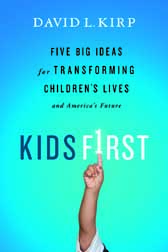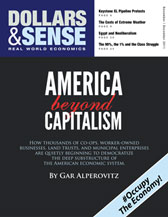
Not Kidding
A review of Kids First: Five Big Ideas for Transforming Children’s Lives and America’s Future, by David Kirp (New York: Public Affairs, 2011).This article is from Dollars & Sense: Real World Economics, available at http://www.dollarsandsense.org

This article is from the November/December 2011 issue of Dollars & Sense magazine.
Subscribe Now
at a 30% discount.
In a famous essay, the British political philosopher Isaiah Berlin drew a distinction between hedgehogs, which focus on just one thing, and foxes, which focus on many things.
Each approach has strengths and weaknesses. Hedgehogs are relentless but not sufficiently diversified. Like Bill Murray in the movie "Groundhog Day," they attempt one thing over and over again until it (hopefully) gets done. The cunning fox devises many strategies to get what it wants and then demands that we do something to achieve that end but fails to prioritize its preferences.
For a number of years, University of California-Berkeley public policy professor David Kirp has focused on the high rate of child poverty in the United States—more than double that of other developed countries, according to Luxembourg Income Study data. In his excellent 2007 book The Sandbox Investment, Kirp was a hedgehog, pushing pre-school education as the strategy of choice for reducing child poverty. In his new book Kids First Kirp becomes a fox, advocating five cradle-to-college investments and describing numerous programs in each category.
Nurse home-visitation programs provide care to disadvantaged mothers during pregnancy and following childbirth. Nurses focus on the mother’s health as well as child rearing practices. Random assignment studies (the gold standard of social science research) have found these programs generate several dollars in future benefits for every dollar spent.
Second is high-quality early education. The Perry Elementary School in Ypsilanti, Mich., began enrolling three and four year olds in pre-school in 1961. Compared to a control group, these youngsters were less likely to skip school or repeat a grade and more likely to stay out of prison and graduate from high school. In their forties, they earned 25% more. Each $1 spent on this program returned $7 in future tax revenues.
Head Start is a bit more controversial. Higher scores on IQ tests tend to fade after several years, although there are lasting gains such as reduced crime and special education needs.
Third, children must be prepared for later life. This requires a good education as well as other important services. The Children’s Health Insurance Program ensures that health, eyesight, or hearing problems don’t keep children from learning. Community schools provide health care and counseling along with traditional academics.
Fourth, troubled youth need mentors. Programs like Big Brothers Big Sisters promote needed norms and establish caring relationships. Youngsters in such mentoring programs do better in school and are less likely to do drugs.
Finally, children need a nest egg for college or starting a business. One possibility is for the government to open a small savings account for each newborn and let parents add to it annually as their children grow.
The numerous examples of successful programs are just one of many strengths of this book. Kirp’s argument that programs should be universal in order to generate public support and ensure no stigma is attached to them is another. Pointing out that these programs are investments that will repay initial expenditures many times over is another. But the greatest strength of this book is Kirp’s passion for improving the lives of low-income children.
There are weaknesses to the strategy of the fox, however. In his enthusiasm to push numerous universal programs, Kirp gets sloppy with his math. He claims it would cost only $50 billion a year to implement all his proposals, less than his estimate for just high-quality preschool in Sandbox.
Foxes can also outfox themselves, missing important trees while running through the forest.
Most developed nations employ two policies to aid families with children. In lieu of tax exemptions for children, which favor wealthy households in high tax brackets and provide no help to those owing no income tax, European families receive a small stipend (a child allowance) for each child. And sadly, the United States is the only developed country without a policy of paid parental leave, significantly reducing family income around the birth of a child.
These policies go a long way to explaining the much lower child poverty rates in Europe. Pushing these two policies until they are adopted in the United States is a project calling for the relentlessness of a hedgehog as well as the cunning of a fox. Perhaps this should be Kirp’s next project.
Did you find this article useful? Please consider supporting our work by donating or subscribing.
